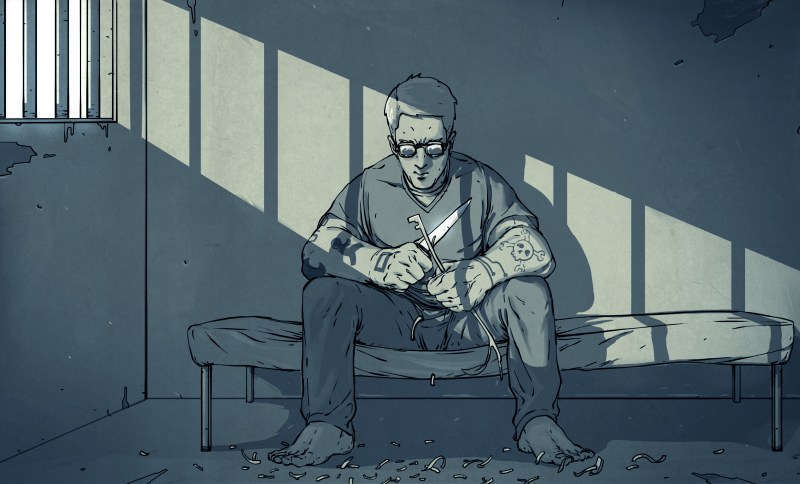In 1978, Tim Jenkin was a man living on borrowed time, and he knew it. A white South African in his late 20s, he had been born into the apartheid system of brutally enforced racial segregation. By his own admission, he didn’t even realize in his youth that apartheid existed — it was just a part of his world. But while traveling abroad in the early 1970s he began to see the injustice of the South African political system, and spurred on by what he learned, he became an activist in the anti-apartheid underground.
Intent on righting the wrongs he saw in his homeland, he embarked on a year of training in London. He returned to South Africa as a propaganda agent with the mission to spread anti-apartheid news and information to black South Africans. His group’s distribution method of choice was a leaflet bomb, which used a small explosive charge to disperse African National Congress propaganda in public places. Given that the ANC was a banned organization, and that they were setting off explosives in a public place, even though they only had a few grams of gunpowder, it was inevitable that Jenkin would be caught. He and cohort Steven Lee were arrested, tried and convicted; Jenkin was sentenced to 12 years in prison, while Lee got eight.
The Keymaster
Unwilling to spend his 30s as a political prisoner, Jenkin began to think his way out of the problem. Housed in the maximum security Pretoria Prison, Jenkin found the first weakness in the system he could exploit: he was housed with only nine other political prisoners, all of whom had the same ideological background. This eliminated the possibility of a jailhouse snitch and allowed him to enlist support as needed. The other advantage was that he and the other inmates were required to labor in the prison carpentry shop, which gave him access to tools and materials.
Another weakness Jenkin exploited was the one offered by all locks: all the information needed to defeat it is encoded in the lock mechanism. Without any locksmithing experience to guide him, Jenkin relied on observation and experiment to determine the configuration of the wards inside the lock on his cell door. Using a piece of paper and a small knife, he took impressions of the lock’s innards and fashioned a wooden key in the carpentry shop. After some adjustments with a file, the key worked on the inner door of his cell, and a similar key rigged to a broomstick served to open his outer door, which was keyed on the outside. Once free from his cell, Jenkin freed Lee, and together they explored the jail, looking for more weaknesses.
Ten Doors to Freedom
They found a total of eight more locked doors between them and freedom, and with a third accomplice, Alex Moumbaris, they spent months systematically probing each door for weaknesses. They worked after lockdown when they knew the guard was on his rounds. Some doors had the same keys as others, but some needed new keys fashioned. Some keys were fashioned from wood, and some used soldered wires. In one particularly daring hack, Jenkin disassembled a lock, filed down the internal levers so that any key would work, and reassembled the lock before being discovered.

Finally, after months of meticulous planning, probing, and fabricating, Jenkin, Lee, and Moumbaris began their escape. Armed with their keys, civilian clothes pilfered from incoming inmates, and with cigar tubes full of carefully hoarded money stashed in the natural place for a cigar full of contraband, the threesome breached the first nine doors. The final door would not yield to picking attempts, so Moumbaris brute-forced the door with a chisel and a screwdriver, much to the dismay of Jenkin, who preferred to leave no trace of their departure. Once they cleared the tenth door, they dissolved into the streets of Pretoria as anonymous civilians. They walked over the border into Swaziland and eventually made contact with the ANC for help getting as far from South Africa as possible.
The tale of Jenkin’s daring prison locksmithing and his escape with Lee and Moumbaris is a remarkable tale of ingenuity and bravery in the face of poor odds of success and a high penalty for failure. Jenkin recently gave a talk at a lockpicking conference in the Netherlands, a video of which is below. It’s a long video but it’s well worth watching, not only for the first-hand details of the expedient locksmithing but for the social engineering that made the escape a success.
There’s also a dramatized version of the escape from the National Geographic channel, which seems to hew closely to Jenkin’s first-hand account. And watch for a major motion picture on the escape starring Daniel Radcliffe and Sam Neil, set to start filming next year. Hollywood may well give short shrift to the hacks Jenkin pulled off when it counted, so to see him talk about his brief career as a prison locksmith in detail to a group of like-minded folks is a real treat.
Many thanks to [Jan-Willem Markus] for the tip.

















Leaflet bombs just sounds like a bad idea even if you’re not being seditious.
They do get attention quickly though.
Today we’d use drones.
Personally, the leaflet bomb still sounds better than using a drone. It’d be cheaper and less risky.
Uhh what about physically placing a bomb is less risky than remotely piloting a drone, exactly?
I don’t think it’s beyond reason for a drone to do more damage than a few grams of gunpowder and paper.
Leaflet mortar would be better, because you don’t need to be seen dropping anything. You can fire from hiding. The parcel airbursts and leaflets drop everywhere.
I prefer a leaflet missile. That way you can fire it from a distance.
Double down on the prison sentence and drop leaflet bombs from drones.
Just go all the way and use a leaflet mortar shooting drones that drop leaflet bombs.
I’m sure the bay area crowd would use their Phantoms for protests like these but roof tops, skyways, and second story windows work too. You could probably even devise a way to use a waterballoon slingshot/catapult to get the leaflets scattered.
A compressed air cylinder would probably get the same result these days, but be somewhat larger and more noticeable than the explosive option. Small air cylinders are also going to be a lot more common these days than in 1978.
Drones capable of carrying a ream of paper aren’t cheap. Paper is heavy in large amounts.
Play stupid games, get arrested.
Hmm?
Are you suggesting that stopping the apartheid system is a stupid game?
No, sticking your neck out will get you into trouble. Sometimes it’s worth it, like when you’re taking down systemic racism.
Political prisoner – making bombs.
Still, I guess a leaflet bomb is better than tyre necklacing a police man. Black or white policeman I might add.
The ANC were terrorists, no matter what their motivation was.
Then again apartheid couldn’t have exist without terrorism on the part of those practicing apartheid So where the victims of apartheid to do? India eliminated colonial rule non violently; Poland precipitated the break up of the USSR without firing a shot, but those where the exceptions not the rule.
Many shots were fired
https://en.wikipedia.org/wiki/Monument_to_the_Fallen_Shipyard_Workers_of_1970
I suppose magicians are terrorists now, for using flash paper.
So true. If you are against the official government, you are a terrorist if you take a little of their monopoly on violence. That is the exact meaning of the word. But remember: stepping up against your government is not always a bad thing. There are plenty of examples where terrorism provided freedom to the people in oppressive governments. Nothing is pure black or white. (pun intended)
Sadly violence is often necessary to overthrow tyranny, but that doesn’t justify committing horrific acts such as “necklacing.” The ANC at it’s core has never cared about truly liberating people . . .
Leaflet “bombs” aren’t intended to hurt people, and not powerful enough to do real damage.
The rest of your post is so asinine I’ll leave it be.
Impressive.
Tim Jenkin’s story gets more interesting after his escape. He helped create an encrypted communications system so ANC operatives could use public telephones to send messages. It was based of a pre-programmed device that would play tones directly into the mouthpiece of the phone. The project was called Operation Vula (shoutout to UCT students that now know where the name comes from.)
There is a dicumentary covering his escape and Vula here https://www.youtube.com/watch?v=zSOTVfNe54A
Tim Jenkin’s story gets more interesting after his escape. He helped create an encrypted communications system so ANC operatives could use public telephones to send messages. It was based of a pre-programmed device that would play tones directly into the mouthpiece of the phone. The project was called Operation Vula (shoutout to UCT students that now know where the name comes from.)
There is a dicumentary covering his escape and Vula here https://www.youtube.com/watch?v=zSOTVfNe54A
Thank you [Dan Maloney] for picking up the suggestion. This post is great! I like the cover picture a lot.
A link to a digital copy of [Tim Jenkins] book can be found in the video description.
“the natural place for a cigar full of contraband”?? My imagination is running wild (and it’s probably correct)
alimentary, my dear Watson …